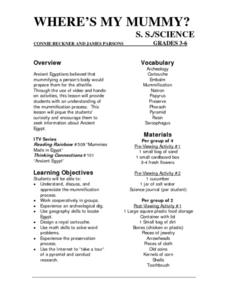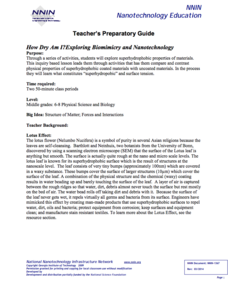Science Friday
Sublime Sublimation
Dry ice isn't dehydrated water, and young scientists learn why in this fascinating presentation. After watching a video, they complete three different activities using dry ice. Upon completion, they discuss the scientific principle.
DiscoverE
Ocean Acidification
Combat ocean acidification with bubbles. Young engineers create a system that reduces the acidity of water. Dry ice in water helps simulate ocean acidity, and blowing bubbles into the water results in a gas exchange that neutralizes the...
Curated OER
Preserving Buds and Blooms
Students learn how to preserve flower buds and blooms. In this gardening activity, students explore the methods of air drying, using drying agents, and pressing plants to preserve them.
Curated OER
Egyptian Sun-Dried Brick
Students explore why Egyptians lived in sun-dried brick homes and step back in time to make a replica of a dwelling that was energy-efficient and environmentally friendly. They measure, mark and cut four pieces of cardboard to build...
Curated OER
Where's My Mummy: Preservation Techniques
To observe preservation techniques firsthand, learners dry a flower in sand and compare cucumber slices soaked in salt water for a week with slices left out to dry in the open air. Video resources (not attached) include one about mummies...
Curated OER
Weather and Water in Ghana
Students research the rainy and dry season to investigate Africa's weather. For this African weather lesson, students use the given websites to research the rainy and dry seasons of Ghana in Africa. Students then read stories about life...
Curated OER
Food Preservation: Food Science, Canning, Gardening
Learners consider the procedures and safety issues involved in food preservation. They conduct experiments in canning, freezing and drying. If everyone can preserve food utilizing a variety of methods and science principles, the...
Curated OER
Dem Dry Bones Take Form
Students discover human anatomy by dancing with a song in class. In this human body instructional activity, students listen to the song "Dem Dry Bones" and identify the different parts of a paper human skeleton. Students perform a...
National Nanotechnology Infrastructure Network
How Dry am I? Exploring Biomimicry and Nanotechnology
Help your classes feel like they can walk on water! An engaging inquiry-based lesson has young scholars experiment with different surface coatings. They make observations about their properties and how they relate to the surface tension...
PBS
Curious George: Sand and Soil
Two sensory tables—wet and dry—allow scholars to use their sense of sight, touch, and smell to observe the changes when the dirt mixes with water. A short video relates the STEM learning experience to a fun video clip where Curious...
Curated OER
Make a Dried Bouquet
Students examine how drying flowers was a popular hobby for Colonial women during the Colonial era in America. They read and discuss an instruction sheet, and create dried-flower bouquets that are hung upside down and tied with a string.
Curated OER
High And Dry
Students explore the similarities and differences between desert environments and their local environment. After examining desert scened painted by Georgia O'Keeffe, they discuss the elements of their desert landscapes. Students use...
Curated OER
Is Dry Cleaning Dangerous?
In this dry cleaning worksheet, students read about the chemicals used to clean clothes and the alternative possibilities for dry cleaning use. Students answer three critical thinking questions about the dangers of the chemical agents...
Curated OER
Cells in Series and Parallel
In this cells in series and parallel worksheet, students connect dry cells in a series and in parallel. Students chart their observations in a given table. Students answer several questions demonstrating their understanding of cells in...
Curated OER
The Big Wet
Students complete a research project. In this climate lesson, students learn about the climate "tropical wet and dry" found in Australia. Students work in groups to research aspects of this climate and then create a class presentation.
Curated OER
What Does the Inside of a Seed Look Like?
First graders study seeds. In this biology lesson, 1st graders observe the differences between dry and wet seeds and draw what is inside a seed after peeling off the outer coat of one of the seeds.
Curated OER
Boot Reer Root Beer
Fifth graders investigate chemical reactions. In this physical science lesson, 5th graders make dry ice root beer and identify the type of change that occurs to the root beer mixture.
Curated OER
Boat Safety and Water Sports - Lesson 20 - Dry Land Wake Board Work
Lesson 20 is part of a 22 lesson unit on boat safety and water sports. The focus in this lesson is getting up on the wake board. If you click on the resource link at the bottom of the page, there is another resource link that goes to the...
American Chemical Society
Changing State: Melting
Dry ice is extremely cold — it is -109.3°F or -78.5°C. Scholars observe and explain the molecular motion associated with melting. Then they design their own experiments to speed up the melting process. Finally, a teacher presents a...
Global Oneness Project
Living with Less Water
Did you know that California produces two thirds of the fruits and nuts consumed in the United States? That it produces almost one third of the vegetables? Did you know that scientists warn that California is facing the onset of a...
DiscoverE
Waterproofing the Roof
Can your pupils build a roof that stands the test of time? Use an insightful engineering design project to highlight both materials science and architecture. Scholars either team up or work as individuals to design, create, and test a...
Council for Economic Education
Tapped Dry: How Do You Solve a Water Shortage?
Students, after evaluating different allocation methods for water, determine the costs and benefits of each method.
Curated OER
The Magic School Bus Dries Up
Learners learn along with Ms. Frizzle's class. In this Magic School Bus lesson plan, students work in small groups to find out if foods they eat contain water.
Curated OER
Step By Step Directions
Perfect for your unit on pumpkins and autumn! Learn how to write step by step directions on how to dry pumpkin seeds based on The Pumpkin Book. Youngesters also explain how they know this is a "how to" book. A fun and yummy lesson plan!
Other popular searches
- Air Dry Clay
- Dry Ice
- Dry Ice Experiments
- Wet and Dry
- Dry Cooking Methods
- Dry Desert
- Dry Bean
- Dry Brush
- Dry Forest
- Dry Measure
- Dry Brushing
- Wet and Dry Environments

























